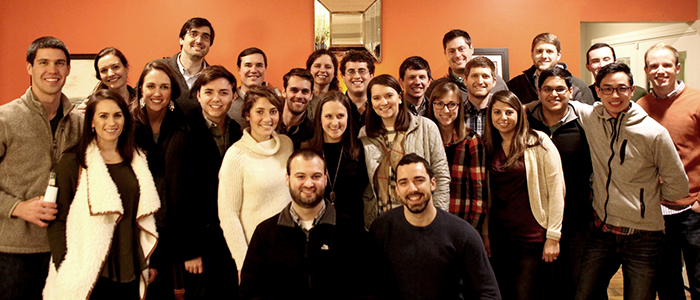by Sarah Marucci, PGY2
After the excitement of finishing intern year settled down, the reality of being a second-year resident and the responsibility, leadership, and sleepless 28-hour calls that come with it hit hard and fast. To combat the anxiety of walking into second year feeling overwhelmed and underprepared, the Internal Medicine program leadership has been holding a PGY2 Retreat for the last several years to help residents embrace their new upper level status and reflect on their growth over the last year. The Program Directors found coverage for PGY2 residents on two separate weekdays in August in order to get residents out of the hospital and into a relaxing environment at the beautiful home of Dr. Willett for a fun day of team activities, discussion, and debriefing.

A group of PGY2s when they were mere PGY1s. They’ll be PGY3s before we know it!
PGY2 residents first worked as individuals and then small groups to rank the most essential supplies needed to survive a journey on the moon as compared to the NASA experts. During this activity, residents focused on communication and team problem solving, both imperative skills to have on their wards teams. Some learned that they would survive well in outer space (who knew that nylon rope and a life raft could be so helpful on the moon?). Others...well, let’s just say they’ll survive residency much better than an excursion to the moon!
One of the most important aspects of becoming an upper level resident is learning how to lead in addition to understanding and appreciating you and your co-residents’ different styles of leadership and how these styles interact. In turn, this creates the goal of creating and maximizing the potential for well-rounded and effective teams. To do this, we utilized the DISC personal assessment tool (Dominant, Influencing, Steady/Supportive, and Conscientious) which takes into account personality, values, and thinking styles to categorize leadership. Residents acknowledged that, for example, the ambitious and driven “D” leaders paired with methodical “C”s or collaborative “S”s may not have the most compatible personalities but their team will likely be productive with work tasks. Enthusiastic “I” leaders, however, will get along very well when working together but will lack efficiency.
The remainder of the morning session was composed of Dr. Kraemer leading a discussion on how to supervise the handoff, a vital but often overlooked component of patient care and a skill that needs to be handed down from upper levels to interns early in the year. The Chief Medical Residents offered advice and answered questions on how to handle the subspecialty wards (Renal, Pulmonary, GI, Oncology) as the resident team leaders. Subs provide the opportunity for PGY2s to truly embrace a leadership role and also the challenges of organizing and setting expectations for a team of 3 to 4 interns, becoming comfortable with staying up-to-date with an entire patient list, understanding criteria for accepting patients to a service, and more. Dr. Massie then spoke to the group about how to give (and receive!) effective feedback of three types: minimal, behavioral, and interactive. During every rotation, both interns and upper level residents frequently ask for and are given feedback with the expectation of receiving and implementing suggestions for improvement well. However, this was one of the first times for the PGY2s to delve deeper into the delicate art and nitty gritty details of actually delivering feedback and daily microfeedback now that they have become team leaders.
At the end of the day, the PGY2 residents discussed major challenges he or she has faced as an intern or already as an upper level--anything from how to address areas of improvement with new interns to difficult patient and family interactions to discord with attendings. It was eye-opening for residents to have their colleagues encourage them in their trials and provide valuable insight on how to best approach conflict. The next two years will bring many challenges and PGY2s will continue to benefit from the support provided as their role as upper level residents is critical to the success of others. This honest and open conversation is yet another testament to how being a part of the UAB Internal Medicine program means being part of a supportive, motivating and widely diverse family of leaders.